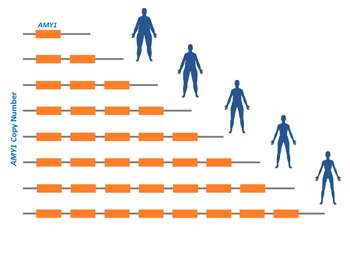Saliva provides a new trail in obesity genetics

Salivary amylase is a gene present in humans. Yet its number of copies can vary from one to 20, depending on the individual. Having a low copy number of the gene, which digests complex sugars (starches), favors obesity, according to an international team led by Professor Philippe Froguel from the Genomique et Maladies Métaboliques laboratory (CNRS/Université Lille 2/Institut Pasteur de Lille). The researchers showed that people with the smallest number of salivary amylase copies (and therefore low amylase levels in the blood) are ten times more at risk of becoming obese. With each unit drop in the number of copies of this gene, the risk of obesity increases by 20%. This work, published on March 30, 2014 in Nature Genetics, reveals for the first time a genetic link between complex carbohydrate digestion and obesity.
One billion people worldwide are overweight. Although obesity has an environmental origin at the population level, in individuals, 70% of the genetic risk in subjects predisposed to obesity is due to genetic factors. About 5% of morbidly obese people carry a mutation in one of the genes that controls appetite, which is enough to make them obese. Recent pan-genomic studies using DNA microarrays identified 70 common obesity genes, but their impact is low and only explains a small part of the genetic risk (4%).
French and British researchers went further by studying obesity-discordant Swedish siblings, analyzing their genome and the genes in adipose tissue, which are expressed differently in obese subjects and in those with normal weight. They identified a region in chromosome 1 that is unique because it contains a gene, salivary amylase (AMY1), present in a single form in humans. Instead of having only two copies of this gene (one from the father, one from the mother) the number of AMY1 copies varies in humans from one to 20. For 10,000 years, since agriculture began, the number of AMY1 copies has increased, evidence of natural selection and human evolution: since amylase digests complex sugars (starches), individuals who secrete high levels of salivary amylase have a selective nutritional advantage. Researchers have noticed that people with the smallest number of AMY1 copies (and therefore little amylase enzyme in their blood) are ten times more at risk of becoming obese. With each unit drop in the number of AMY1 copies, the risk of obesity increases by 20%. Alone, this region of the genome explains almost 10% of the genetic risk.
There are two forms of amylase: one produced by the pancreas and the other by the salivary glands. Only the salivary form seems to be associated with obesity. It is not yet known why a salivary amylase deficiency increases obesity: two hypotheses are under consideration. The first is that chewing and partially digesting food in the mouth could have a hormonal effect inducing satiety, which would be reduced in the case of AMY1 deficiency. The second is that poor starch digestion could change the intestinal flora, thereby contributing indirectly to obesity or even diabetes. That is what initial metabolomic studies conducted in patients with high or low salivary amylase suggest. Thus, individuals with low salivary amylase have abnormally high glycemia when they eat starch.
These entirely novel findings point to a genetic predisposition to obesity via complex carbohydrate digestion and its effects on the intestinal bacterial flora. They open important perspectives for more effective obesity prevention and treatment that take into account food digestion and degradation in the intestines.
More information: "Low copy number of the salivary amylase gene predisposes to obesity." Mario Falchi, et al. Nature Genetics, March 30, 2014. DOI: 10.1038/ng.2939

















